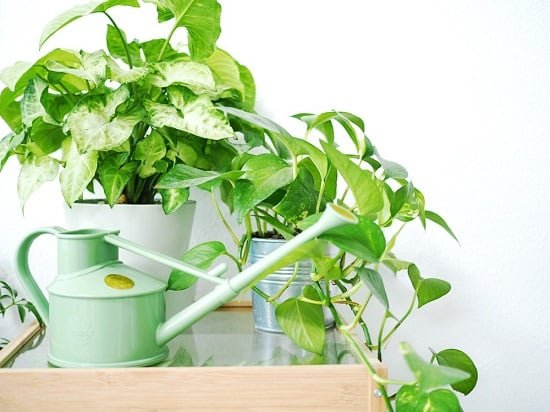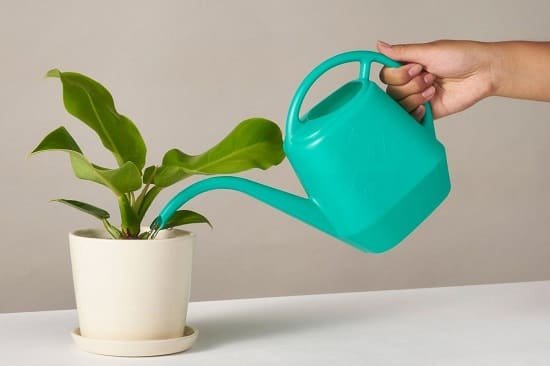Know all about Watering Indoor Plants in this post. With these tips, you’ll be able to prevent the untimely death of your beloved houseplants that die on you!
Watering Indoor Plants can be a tricky business, especially if you are growing houseplants for the first time. It all depends on the plant’s needs, and while some plants respond well to particular watering techniques, others might not be well suited for the same. Here is all you need to know about How to Water Houseplants!
Check out our article on how to water houseplants when you are away here
Knowing Plants’ Needs
As mentioned above, watering needs changes from plant to plant. For instance, you can’t water cacti with the same liberty as you water most ferns. Before you plant any variety, make sure to research its watering needs. While some plants like to stay on the drier side, some want the soil to remain moist, so it all changes from plant to plant.
There are signs that plants show when they are overwatered or underwatered, such as dry and brittle leaves are an indication of lack of watering. When overwatered, the foliage turns yellow, hanging, and limp. Watching out for these signs can give you an idea about plants’ needs and change watering cycles before it’s too late.
The Most Important Trick
Indoor plants most commonly suffer from overwatering. They sit in moist soil for a long time, which leads to root rot. It’s due to the lack of sunlight and wind they receive in the closed environment causing less or no evaporation of water.
The best way to keep your plants alive indoors is to water sensibly, only when the topsoil is dry, especially if you’re growing them in complete shade, in indirect sunlight. Poke your index finger 1-2 inches inside (shove it deeper if you’re dealing with a deep and narrow, large pot) to feel the moisture level.
Check out top houseplant watering rules to follow here
Top Watering Techniques
There are various ways to water plants. The selection depends on the plant and also on the gardener’s convenience. Mainly there are two ways: “Watering from above” and “watering from below.”
1. Watering from Above
It’s the most common watering technique, and most indoor plants are watered this way. Water is poured from above over the foliage (aka overhead watering) or at the base depending on the plant. Most of the tropical plants and ferns won’t mind if the foliage gets wet.
Some plants are more prone to fungal infections, so it’s always safe to prefer watering at the base, from the soil level of the plant without wetting the foliage and crown.
2. Watering from Below
This method of watering is most suitable for plants that don’t like wet foliage and stems. Get a tray large enough to fit in the container and fill it with water to around 2 cm. Place the pot over this tray and leave it for 20 minutes before bringing the pot again at its original spot. Make sure that the pot has drainage holes at the bottom. That’s it!
Have a look at the benefits of bottom watering your plants here
Characteristics of Water
Water has various characteristics which you need to be aware of before watering indoor plants. It includes factors such as temperature and type of water.
Type of Water
Tap water usually contains chlorine and fluoride, which can cause harm to your plants. You can leave the water undisturbed for 24 hours will dissipate the chlorine from it and makes it safe for watering. Too much salt in soft water or alkaline water can also cause various problems for the plants.
The best water for the plant is rainwater as it’s natural and free from any sort of contamination. You can also go for bottled water, although that might be quite expensive. Filtered, RO, purified water, and aquarium water are also options. You can also opt for borewell water but get it tested if it’s not rich in fluoride and other minerals.
Temperature of Water
Room temperature water is most suitable for indoor plants. A bit lukewarm water won’t do any harm, but if the water is cold or freezing, it can be fatal. So the next time you water plants make sure that the water is left at room temperature for some time, so it returns to the standard temperature.
Learn how to bottom water your houseplants here
Additional Tips
- Be mindful of the weather, reduce watering in rainy and humid weather. You’ll need to do the same during winters.
- Water more in summers, during warmer months, it’s essential to water regularly.
- Always do a thorough watering until it starts to drain out from the bottom. Doing this will also prevent the accumulation of fertilizer salts.
- The best time to water your plants is early to late morning when the evaporation and transpiration rate is high. Watering at night promotes dampness, damp leaves and stems easily suffer from fungal attacks.
- If you’re growing air plants in your home, find out what’s the proper way to water them here.




